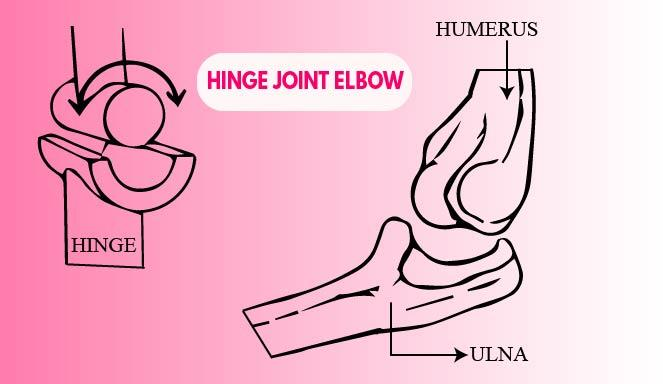
Give two examples of hinge joints.
Answer
479.4k+ views
Hint: This type of joint permits movement in one plane around the transverse axis. This movement consists of flexion and extension. These joints have strong collateral ligaments to prevent other movements.
Complete step by step answer:
In the hinge joint the convex surface of one bone fits into the concave surface of another bone like ulna and humerus in the elbow. This type of joint permits movement on one side only like a door. This movement consists of flexion and extension.
Two examples are the elbow and the phalanges.

Additional information:
Joint in Elbow:
- Articulation: The articular surfaces are covered with hyaline cartilage.
- Type: Synovial hinge joint
- Capsule: From anteriorly it's attached above to the humerus along the upper margins of the coronoid and radial fossa and to the front of the medial and lateral epicondyles and below to the margin of the processus coronoideus of the ulna and to the annular ligament, which surrounds the top of the radius. - Posteriorly it's attached above to the margins of the olecranon fossa of the humerus and below to the upper margin and sides of the olecranon of the ulna and to the annular ligament.
- Synovial membrane is continuous below with the synovium of the proximal radioulnar joint.
Joint in the phalanges:
- Articulation: this is often between the distal end of the radius and therefore therefore the articular disc above and the scaphoid, lunate, and triquetral bones below.
- Type: Synovial ellipsoid joint.
- Ligaments: Anterior and posterior ligaments strengthen the capsule. The medial ligament is attached to the process of the ulna and to the triquetral. The lateral ligament is attached to the process of the radius and to the os scaphoideum.
- Nerve supply: Anterior interosseous nerve and therefore the deep branch of the nervus radialis.
Note:
- Kinesiology: It is the study of the motion of the human body.
- Osteoclasts are bone reabsorbing cells and which are responsible for demineralization of bone.
Most joints are flexible, allowing the bones to move. Each joint is made up of bones involved with a joint cavity and a joint capsule. Joints consist of cartilage which is a type of tissue that covers the surface of a bone at a joint. Joints are held in place by tissues called ligaments. The main joints of the body are found at the hip, shoulders, elbows, knees, wrists, and ankles are freely movable.
Complete step by step answer:
In the hinge joint the convex surface of one bone fits into the concave surface of another bone like ulna and humerus in the elbow. This type of joint permits movement on one side only like a door. This movement consists of flexion and extension.
Two examples are the elbow and the phalanges.

Additional information:
Joint in Elbow:
- Articulation: The articular surfaces are covered with hyaline cartilage.
- Type: Synovial hinge joint
- Capsule: From anteriorly it's attached above to the humerus along the upper margins of the coronoid and radial fossa and to the front of the medial and lateral epicondyles and below to the margin of the processus coronoideus of the ulna and to the annular ligament, which surrounds the top of the radius. - Posteriorly it's attached above to the margins of the olecranon fossa of the humerus and below to the upper margin and sides of the olecranon of the ulna and to the annular ligament.
- Synovial membrane is continuous below with the synovium of the proximal radioulnar joint.
Joint in the phalanges:
- Articulation: this is often between the distal end of the radius and therefore therefore the articular disc above and the scaphoid, lunate, and triquetral bones below.
- Type: Synovial ellipsoid joint.
- Ligaments: Anterior and posterior ligaments strengthen the capsule. The medial ligament is attached to the process of the ulna and to the triquetral. The lateral ligament is attached to the process of the radius and to the os scaphoideum.
- Nerve supply: Anterior interosseous nerve and therefore the deep branch of the nervus radialis.
Note:
- Kinesiology: It is the study of the motion of the human body.
- Osteoclasts are bone reabsorbing cells and which are responsible for demineralization of bone.
Most joints are flexible, allowing the bones to move. Each joint is made up of bones involved with a joint cavity and a joint capsule. Joints consist of cartilage which is a type of tissue that covers the surface of a bone at a joint. Joints are held in place by tissues called ligaments. The main joints of the body are found at the hip, shoulders, elbows, knees, wrists, and ankles are freely movable.
Recently Updated Pages
How do you factor x2 + x 20 0 class 9 maths CBSE

How do you solve y6x and 2x+3y20 using substitutio class 9 maths CBSE

Chipko movement originated in Gopeshwar in A 1953 B class 9 biology CBSE

The adjacent sides in the parallelogram are supplementary class 9 maths CBSE

The compound used in plastic industry is A Vinyl acetate class 9 chemistry CBSE

How do you solve for y in 2left y dfrac12 right 4left class 9 maths CBSE

Trending doubts
According to Bernoullis equation the expression which class 11 physics CBSE

Draw a diagram of nephron and explain its structur class 11 biology CBSE

Differentiate between calcination and roasting class 11 chemistry CBSE

A solution of a substance X is used for white washing class 11 chemistry CBSE

What is spore formation class 11 biology CBSE

10 examples of friction in our daily life




